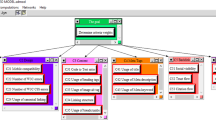Abstract
This paper presents application of a newly developed multi-criteria decision-making (MCDM) method, i.e. Proximity Indexed Value (PIV) method for the ranking and selection of the E-learning websites. PIV is a computationally simpler method as compared to other MCDM methods such as AHP, VIKOR, COPRAS, WEDBA, WDBA, and it also minimises the rank reversal problem. The applicability and efficacy of the PIV method has been demonstrated with the help of two illustrative examples pertaining to the selection of the E-learning websites which have already been solved by researchers using different MCDM methods. Results of this study revealed that the ranking of the E-learning websites obtained by the PIV method exactly matched with those derived by AHP, VIKOR and COPRAS. However, a small difference in the ranking by PIV method with those of WEDBA and WDBA was observed. It suggests that PIV method is a simple, effective and efficient method which can be used to solve different types of problems related to the ranking and selection of alternatives.

Similar content being viewed by others
References
Alias, N., Zakariah, Z., Ismail, N. Z., & Aziz, M. N. A. (2012). E-learning successful elements for higher learning institution in Malaysia. Procedia -Social and Behavioral Sciences, 67, 484–489.
Aparicio, M., Bacao, F., & Oliveira, T. (2016). An e-learning theoretical framework. Journal of Educational Technology & Society, 19(1), 292–307.
Cheawjindakarn, B., Suwannatthachote, P., & Theeraroungchaisri, A. (2012). Critical success factors for online distance learning in higher education: a review of the literature. Creative Education, 3(8), 61.
Covella, G. J., Olsina Santos, L. A. (2002). Specifying quality characteristics and attributes for E Learning sites. In IV Workshop de Investigadoresen Ciencias de la Computación
Ehlers, U. D. (2004). Quality in e-learning from a learner’s perspective. European Journal of Open, Distance and E-learning, 101, 1–7.
FitzPatrick, T. (2012). Key success factors of eLearning in education: A professional development model to evaluate and support eLearning. Online Submission.
Garg, R. (2017). Optimal selection of E-learning websites using multi attribute decision-making approaches. Journal of Multi-Criteria Decision Analysis, 24(3–4), 187–196.
Garg, R., & Jain, D. (2017). Fuzzy multi-attribute decision making evaluation of e-learning websites using FAHP, COPRAS, VIKOR. WDBA. Decision Science Letters, 6(4), 351–364.
Govindasamy, T. (2001). Successful implementation of e-learning: Pedagogical considerations. The Internet and Higher Education, 4(3–4), 287–299.
Jain, D., Garg, R., Bansal, A., & Saini, K. K. (2016). Selection and ranking of E-learning websites using weighted distance-based approximation. Journal of Computers in Education, 3(2), 193–207.
Le Blanc, A., Wands, M. (2001). Critical success factors: E-learning solutions cappuccino. The official E-Newsletter of the Change and Learning Practice2.
Mahanta, D., & Ahmed, M. (2012). E-learning objectives, methodologies, tools and its limitation. International Journal of Innovative Technology and Exploring Engineering, 2, 46–51.
Mosakhani, M., Jamporazmey, M. (2010). Introduce critical success factors (CSFs) of e-learning for evaluating e-learning implementation success, In Proceedings of the Educational and Information Technology (ICEIT), 2010 International Conference (Vol. 1, pp. V1-224). IEEE.
Mufazzal, S., & Muzakkir, S. M. (2018). A new multi-criterion decision making (MCDM) methodbased on proximity indexed value for minimizing rank reversals. Computers & Industrial Engineering, 119, 427–438.
Ozkan, S., Koseler, R. (2009). Multi-dimensional evaluation of E-learning systems in the higher education context: an empirical investigation of a computer literacy course, Proceedings of the Frontiers in Education Conference, 2009. FIE’09. 39th IEEE (pp. 1–6). IEEE.
Oztekin, A., Delen, D., Turkyilmaz, A., & Zaim, S. (2013). A machine learning-based usability evaluation method for eLearning systems. Decision Support Systems, 56, 63–73.
Öztürk, Z. K. (2014). Using a multi criteria decision making approach for Open and distance learning system selection. Anadolu University Journal of Science and Technology, 15(1), 1–14.
Pruengkarn, R., Praneetpolgrang, P., Srivihok, A. (2005). An evaluation model for e-learning Websites in Thailand University, Proceedings of the Advanced Learning Technologies, 2005. ICALT 2005. Fifth IEEE International Conference (pp. 161–162). IEEE.
Saaty, T. L. (1980). The analytic hierarchy process (p. 1980). New York: McGraw-Hill.
Sela, E., & Sivan, Y. Y. (2009). Enterprise e-learning success factors: An analysis of practitioners’ perspective (with a downturn addendum). Interdisciplinary Journal of E-Learning and Learning Objects, 5(1), 335–343.
Selim, H. M. (2007). Critical success factors for E-learning acceptance: Confirmatory factor models. Computers & Education, 49(2), 396–413.
Soong, M. B., ChanHC, Chua B. C., & Loh, K. F. (2001). Critical success factors for on-line course resources. Computers & Education, 36(2), 101–120.
Volery, T., & Lord, D. (2000). Critical success factors in online education. International Journal of Educational Management, 14(5), 216–223.
Vukovac, D. P., Kirinic, V., & Klicek, B. (2010). A comparison of usability evaluation methods for e-learning systems (pp. 271–289). Vienna: DAAAM International Scientific Book.
Xaymoungkhoun, O., Bhuasiri, W., Rho, J. J., Zo, H., & Kim, M. G. (2012). The critical success factors of e-learning in developing countries. Korea, 305, 701.
Yunus, Y., & Salim, J. (2013). E-learning evaluation in Malaysian public sector from the pedagogical perspective: Towards e-learning effectiveness. Journal of Theoretical & Applied Information Technology, 51(2), 201–210.
Zaman, W., Ghosh, P., Datta, K., & Basu, P. N. (2012). A framework to incorporate quality aspects for e-learning system in a consortium environment. International Journal of Information and Education Technology, 2(2), 159.
Author information
Authors and Affiliations
Corresponding author
Additional information
Publisher's Note
Springer Nature remains neutral with regard to jurisdictional claims in published maps and institutional affiliations.
Rights and permissions
About this article
Cite this article
Khan, N.Z., Ansari, T.S.A., Siddiquee, A.N. et al. Selection of E-learning websites using a novel Proximity Indexed Value (PIV) MCDM method. J. Comput. Educ. 6, 241–256 (2019). https://doi.org/10.1007/s40692-019-00135-7
Received:
Revised:
Accepted:
Published:
Issue Date:
DOI: https://doi.org/10.1007/s40692-019-00135-7




